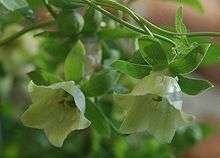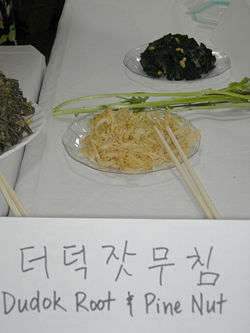Codonopsis
| bonnet bellend flowers | |
|---|---|
 | |
| Codonopsis pilosula | |
| Scientific classification | |
| Kingdom: | Plantae |
| (unranked): | Angiosperms |
| (unranked): | Eudicots |
| (unranked): | Asterids |
| Order: | Asterales |
| Family: | Campanulaceae |
| Genus: | Codonopsis Wall. (1824) |
| Synonyms[1] | |
| |
Codonopsis is a genus of flowering plant in the family Campanulaceae. As currently recognized, Codonopsis includes two other groups sometimes separated as distinct genera, i.e. Campanumoea and Leptocodon.[1][2][3][4] The enlarged genus Codonopsis is widespread across eastern, southern, central, and southeastern Asia, including China, Japan, the Russian Far East, Kazakhstan, the Indian Subcontinent, Iran, Indochina, Indonesia, etc.
Uses
Medicinal uses
C. pilosula (Chinese: 党参; pinyin: dǎngshēn) is an important medicinal herb in traditional Chinese medicine.[5]
Food uses

Deodeok muchim, a Korean salad made from C. lanceolata
C. lanceolata (Korean: deodeok) is used as a food in Korean cuisine.
Species
Species currently (July 2014) accepted by Kew's World Checklist.[1] Species with no range given are endemic to China
- Codonopsis affinis – China, Himalayas, Myanmar (Chinese: 大叶党参)
- Codonopsis alpina – (高山党参)
- Codonopsis argentea – (银背叶党参)
- Codonopsis benthamii – China, Himalayas, Myanmar
- Codonopsis bhutanica – Bhutan, Nepal, Tibet
- Codonopsis bragaensis – Nepal
- Codonopsis bulleyana – (管钟党参)
- Codonopsis canescens – (灰毛党参)
- Codonopsis cardiophylla – (光叶党参)
- Codonopsis chimiliensis – Yunnan,Myanmar (滇湎党参)
- Codonopsis chlorocodon – (绿钟党参)
- Codonopsis clematidea – Central Asia, Tibet, Xinjiang, Iran, Afghanistan, Pakistan, western Himalayas (新疆党参)
- Codonopsis convolvulacea – Tibet, Yunnan, Nepal, Bhutan, Assam, Myanmar (鸡蛋参)
- Codonopsis cordifolioidea – (心叶党参)
- Codonopsis deltoidea – (三角叶党参)
- Codonopsis dicentrifolia – Tibet, Nepal, Bhutan, Assam (珠峰党参)
- Codonopsis efilamentosa – Yunnan, Myanmar
- Codonopsis farreri – Yunnan, Myanmar – (秃叶党参)
- Codonopsis foetens – China, eastern Himalayas (臭党参)
- Codonopsis forrestii – China, Myanmar
- Codonopsis gombalana – (贡山党参)
- Codonopsis gracilis – Yunnan, Myanmar, Nepal, Bhutan, Assam
- Codonopsis henryi – (川鄂党参)
- Codonopsis hirsuta
- Codonopsis hongii
- Codonopsis inflata Tibet, Nepal, Bhutan, Assam
- Codonopsis javanica – widespread across China, Japan, Himalayas, Indochina, Java, Sumatra
- Codonopsis kawakamii – Taiwan (台湾党参)
- Codonopsis lanceolata – China, Korea, Japan, Russian Far East (羊乳)
- Codonopsis levicalyx – (光萼党参)
- Codonopsis limprichtii
- Codonopsis macrophylla – Tibet
- Codonopsis mairei
- Codonopsis meleagris – (珠鸡斑党参)
- Codonopsis micrantha – (小花党参)
- Codonopsis minima – Korea
- Codonopsis nepalensis – Nepal
- Codonopsis ovata Pakistan, Kashmir
- Codonopsis pianmaensis
- Codonopsis pilosula – China, Mongolia, Korea, Primorye (党参)
- Codonopsis purpurea – Tibet, Yunnan, Himalayas (India, Nepal, Bhutan) (紫花党参)
- Codonopsis rosulata – (莲座状党参)
- Codonopsis rotundifolia – Tibet, Yunnan, Himalayas (India, Pakistan, Nepal, Bhutan)
- Codonopsis subglobosa – (球花党参)
- Codonopsis subscaposa – (抽葶党参)
- Codonopsis subsimplex – Tibet, Himalayas (India, Nepal, Bhutan) (藏南党参)
- Codonopsis thalictrifolia – Tibet, Himalayas (India, Nepal, Bhutan) – (唐松草党参)
- Codonopsis tsinglingensis – (秦岭党参)
- Codonopsis tubulosa – (管花党参)
- Codonopsis ussuriensis – China, Japan, Korea, Primorye (雀斑党参)
- Codonopsis vinciflora
- Codonopsis viridiflora – (绿花党参)
- Codonopsis viridis – Tibet, Himalayas (India, Pakistan, Nepal, Bhutan)
References
- 1 2 3 Kew World Checklist of Selected Plant Families
- ↑ K.E. Morris and T.G. Lammers (1997). "Circumscription of Codonopsis and the allied genera Campanumoea and Leptocodon (Campanulaceae: Campanuloideae). I. Palynological data". Bot. Bull. Acad. Sin. 36: 277–284.
- ↑ Govaerts, R. (1999). World Checklist of Seed Plants 3(1, 2a & 2b): 1-1532. Continental Publishing, Deurne.
- ↑ Flora of China v 19 p 505, 桔梗科 jie geng ke, Campanulaceae
- ↑ Li, C. Y., et al. (2009). Quality assessment of Radix Codonopsis by quantitative nuclear magnetic resonance. Journal of Chromatography A 1216(11) 2124-29.
| Wikimedia Commons has media related to Codonopsis. |
This article is issued from Wikipedia - version of the 4/7/2015. The text is available under the Creative Commons Attribution/Share Alike but additional terms may apply for the media files.